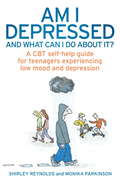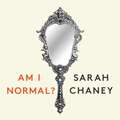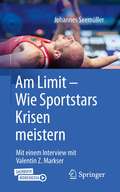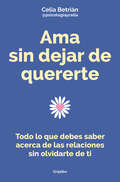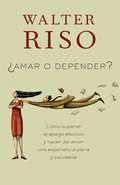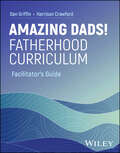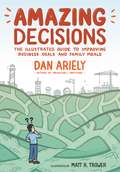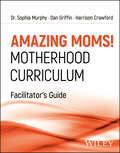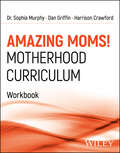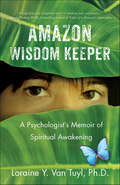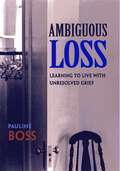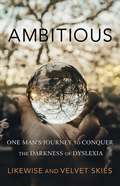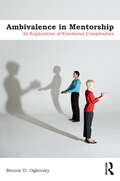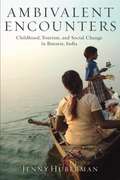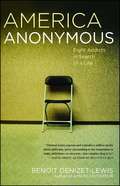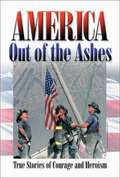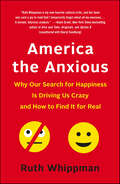- Table View
- List View
Am I Depressed And What Can I Do About It?: A CBT self-help guide for teenagers experiencing low mood and depression
by Shirley Reynolds Monika ParkinsonDepression is one of the most common mental health problems and is estimated to affect around 15% of people at some point during their life. For many people depression is a life-long disorder which starts during the teenage years ?around 10% of teenagers are estimated to have an episode of depression and many more experience persistent low mood. This accessible, engaging and age-appropriate self-help guide based on current research and best practice (NICE, IAPT treatment pathways, Books on Prescription, all of which promote CBT) for young people aged 13 to 17 who experience low mood and depression, and their friends, family and health professionals. The book adopts a narrative approach with graphic elements, incorporating case studies and including some interactive exercises. It provides an essential bridge for young people who have not yet asked for professional help as well as support for those who are waiting for treatment.
Am I Depressed And What Can I Do About It?: A CBT self-help guide for teenagers experiencing low mood and depression
by Shirley Reynolds Monika ParkinsonDepression is one of the most common mental health problems and is estimated to affect around 15% of people at some point during their life. For many people depression is a life-long disorder which starts during the teenage years -around 10% of teenagers are estimated to have an episode of depression and many more experience persistent low mood.This accessible, engaging and age-appropriate self-help guide based on current research and best practice (NICE, IAPT treatment pathways, Books on Prescription, all of which promote CBT) for young people aged 13 to 17 who experience low mood and depression, and their friends, family and health professionals. The book adopts a narrative approach with graphic elements, incorporating case studies and including some interactive exercises. It provides an essential bridge for young people who have not yet asked for professional help as well as support for those who are waiting for treatment.
Am I Normal?: The 200-Year Search for Normal People (and Why They Don’t Exist)
by Sarah ChaneyA deep dive into the strange science of the 'Normal', and the roots of an anxiety-ridden modern obsessionBefore the nineteenth century, the term normal was rarely ever associated with human behaviour. Normal was a term used in maths, for right angles. People weren't normal; triangles were.But from the 1830s, this branch of science really took off across Europe and North America, with a proliferation of IQ tests, sex studies, a census of hallucinations - even a UK beauty map (which concluded the women in Aberdeen were "the most repellent"). This book tells the surprising history how the very notion of the normal came about, how it shaped us all, often while entrenching oppressive values. Sarah Chaney looks at why we're still asking the internet: Do I have a normal body? Is my sex life normal? Are my kids normal? And along the way, she challenges why we ever thought it might be a desirable thing to be.
Am Limit – Wie Sportstars Krisen meistern: Mit einem Interview mit Valentin Z. Markser
by Johannes SeemüllerMedaillen und Titel sind die Währung erfolgreicher Sportler. Wer ganz oben steht, wird von den Medien zum Star gemacht und von den Fans verehrt. Hierfür gehen Leistungssportler an ihre körperlichen und mentalen Grenzen – und oft darüber hinaus. In diesem Buch erzählen Olympiasieger, Weltmeister und Champions League-Sieger durch exklusiv geführte Interviews über ihre Leidenschaft für den Sport. Sie berichten aber auch ungeschminkt über die Schattenseiten. Leistungsdruck, Burnout, Schmerzen, Magersucht, Depressionen, Ängste – nichts ist ihnen fremd. Gerald Asamoah · Matthias Behr · Karla Borger · Timo Hildebrand · Ottmar Hitzfeld · Clara Klug · Michael Köllner · Dominik Nerz · Elisabeth Seitz · Frank Stäbler · Kristina Vogel Selten sprachen Spitzensportler so offen darüber, wie sie mit Rückschlägen und Krisen umgegangen sind. Das Buch enthält abrufbare Videoausschnitte aus den geführten Gesprächen. Ergänzt werden die Porträts durch ein ausführliches Interview mit Dr. Valentin Z. Markser, einem der renommiertesten deutschen Sportpsychiater.
Am liebsten beides: Wie gelange ich zu passenden Entscheidungen?
by Lukas NiederbergerDieses Buch befasst sich mit den wenigen bewusst, frei und ganzheitlich getroffenen Entscheidungen, die wegweisend für unser Leben sind. Dieses Buch vermittelt keine fertigen Rezepte, sondern bietet hilfreiche Werkzeuge, damit die Wahl zwischen zahllosen Optionen nicht zur Qual wird, sondern zur Möglichkeit, unser Leben in Verbindung mit unseren Zielen und Werten selbstbestimmt zu führen.
Ama sin dejar de quererte: Todo lo que debes saber acerca de las relaciones sin olvidarte de ti
by Celia Betrián (@psicologiaycelia)Aprende a detectar y alejarte de relaciones tóxicas e insanas, y consigue la independencia afectiva y la estabilidad emocional. Vive el amor de forma saludable y libre. Amar no significa que dejes de ser tú. En el momento en que lo entregas todo a la otra persona, por necesidad, obligación o desconocimiento, ¿dónde quedas tú? Si tu vida está dirigida por creencias rígidas, dependencia emocional y baja autoestima, llegarás a un callejón sin salida que te impedirá disfrutar de una relación amorosa y, mucho más importante, de la relación que tienes contigo. Este libro revela, entre otras cosas, los peligrosos mitos del amor romántico y los miedos que impiden avanzar hacia la independencia afectiva. Nada mejor para la construcción de la propia autoestima que conocer lo que debes saber acerca de las relaciones sin olvidarte de ti.
Amar o depender
by Walter RisoAunque la psicología ha avanzado en el tema de las adicciones, en el tema de la adicción afectiva el vacío es innegable Este libro está dirigido a todas aquellas personas que quieren hacer del amor una experiencia plena, alegre y saludable. Walter Riso Entregarse afectivamente no implica desaparecer sino integrarse en el otro. El amor sano es una suma de dos en la que nadie pierde. Sin embargo, millones de personas en todo el mundo son víctimas de relaciones amorosas inadecuadas y no saben qué hacer al respecto, ya que el miedo a la pérdida, a la soledad o al abandono contamina el vínculo amoroso y lo vuelve altamente vulnerable. Un amor inseguro es una bomba que puede estallar en cualquier momento y lastimarnos profundamente. En ¿Amar o depender?, Walter Riso, uno de los más conocidos autores de autoayuda, nos enseña que sí es posible vivir con independencia y aun así seguir amando, eliminando las ataduras psicológicas y manteniendo vivo el fuego del amor. La adicción afectiva es una enfermedad que tiene cura y, lo más importante, puede prevenirse. Este revelador libro pretende ayudar a aquellas personas que son o han sido víctimas de un amor malsano y guiar a las parejas sanas para que sigan trabajando en la costumbre de amar intensamente y sin apegos.
Amazing Dads! Fatherhood Curriculum, Facilitator's Guide
by Dan Griffin Harrison CrawfordThe only trauma-informed curriculum designed to turn men into great dads Amazing Dads Fatherhood Curriculum teaches fathers with kids of all ages to become exceptional parents. These detailed lessons meet dads where they are, starting from the common tendencies of male socialization to help explain key concepts of healthy fathering. Through a trauma-informed approach, this curriculum creates safety in the group setting while delving into critical topics that fathers simply do not tend to talk about with people in their lives. Unlike other fatherhood curricula, Amazing Dads addresses a breadth of topics, empowering men to discuss issues like family of origin, sexuality, how punishment can turn into abuse, self-care, and how toxic messages in the culture can hinder parent-child relationships. Each session incorporates grounding and breathing exercises, in addition to activities, exercises, and experiential opportunities that allow participants to connect with the material on a meaningful level. By the end of this course, fathers will have gained the increased self-awareness needed to enhance their relationships with their children and other family members. Lead fathers through a curriculum of targeted lessons focused on how male socialization affects their parenting Guide participants through exercises for developing relational, communication, and conflict resolution skills Connect with dads on a meaningful level by creating a safe space for discussions of trauma and other difficult subjects Explain important parenting concepts using examples, hands-on activities, and more This curriculum is excellent for use in parenting groups, behavioral health treatment programs, addiction treatment programs, and other community-based programs serving fathers. Dads of all backgrounds, with kids of all ages, will benefit from the wisdom in Amazing Dads Fatherhood Curriculum.
Amazing Dads! Fatherhood Curriculum, Workbook
by Dan Griffin Harrison CrawfordThe only trauma-informed curriculum designed to turn men into great dads Amazing Dads Fatherhood Curriculum teaches fathers with kids of all ages to become exceptional parents. These detailed lessons meet dads where they are, starting from the common tendencies of male socialization to help explain key concepts of healthy fathering. Through a trauma-informed approach, this curriculumcreates safety in the group setting while delving into critical topics that fathers simply do not tend to talk about with people in their lives. Unlike other fatherhood curricula, Amazing Dads addresses a breadth of topics, empowering men to discuss issues like family of origin, sexuality, how punishment can turn into abuse, self-care, and how toxic messages in the culture can hinder parent-child relationships. Each session incorporates grounding and breathing exercises, in addition to activities, exercises, and experiential opportunities that allow participants to connect with the material on a meaningful level. By the end of this course, fathers will have gained the increased self-awareness needed to enhance their relationships with their children and other family members. Lead fathers through a curriculum of targeted lessons focused on how male socialization affects their parenting Guide participants through exercises for developing relational, communication, and conflict resolution skills Connect with dads on a meaningful level by creating a safe space for discussions of trauma and other difficult subjects Explain important parenting concepts using examples, hands-on activities, and more This curriculum is excellent for use in parenting groups, behavioral health treatment programs, addiction treatment programs, and other community-based programs serving fathers. Dads of all backgrounds, with kids of all ages, will benefit from the wisdom in Amazing Dads Fatherhood Curriculum.
Amazing Decisions: The Illustrated Guide to Improving Business Deals and Family Meals
by Dan ArielyDan Ariely, the New York Times bestselling author of Predictably Irrational, and illustrator Matt R. Trower present a playful graphic novel guide to better decision-making, based on the author’s groundbreaking research in behavioral economics, neuroscience, and psychology. The internationally renowned author Dan Ariely is known for his incisive investigations into the messy business of decision-making. Now, in Amazing Decisions, his unique perspective—informed by behavioral economics, neuroscience, and psychology—comes alive in the graphic form. The illustrator Matt R. Trower’s playful and expressive artwork captures the lessons of Ariely’s groundbreaking research as they explore the essential question: How can we make better decisions?Amazing Decisions follows the narrator, Adam, as he faces the daily barrage of choices and deliberations. He juggles two overlapping—and often contradictory—sets of norms: social norms and market norms. These norms inform our thinking in ways we often don’t notice, just as Adam is shadowed by the “market fairy” and the “social fairy,” each compelling him to act in certain ways. Good decision-making, Ariely argues, requires us to identify and evaluate the forces at play under different circumstances, leading to an optimal outcome. Amazing Decisions is a fascinating and entertaining guide to developing skills that will prove invaluable in personal and professional life.
Amazing Moms! Motherhood Curriculum, Facilitator's Guide
by Dan Griffin Harrison Crawford Sophia MurphyA transformative, 19-session workshop that helps moms build the skills and self-confidence to become the best mothers they can be Trauma is widely prevalent among parents, and it can affect mothers’ ability to form healthy relationships with their children. Amazing Moms! is the first thoroughly trauma-informed curriculum designed specifically to help mothers unpack their personal histories and learn techniques for becoming better parents. Covering an unusually broad list of topics, from emotional regulation and discipline to families of origin and societal expectations of mothers, the sessions create opportunities for interactive learning and personal growth. Amazing Moms! accommodates all learning styles and includes activities to help create a trusting atmosphere where participants feel safe opening up and engaging with the material. The curriculum also features: Small group activities, grounding exercises, and participant-led lessonsActivities that incorporate art, physical movement, roleplays, and between-session exercisesPractical skills and tools mothers can use with, and teach to, their childrenEnhanced communication skills for healthy conflict resolutionA candid discussion of sex, sexuality, and intimacy, and how to begin having healthy dialogue about these topics with childrenStrategies for finding balance and prioritizing self-careExploration of the changing roles and expectations of women and mothers, woven throughout the sessions Based on current scientific evidence and developed by leading researchers and practitioners in the field, Amazing Moms! offers a unique perspective on motherhood, connecting participants with themselves so they can better connect with their children. Amazing Moms! is both inspired by and a companion to the Amazing Dads! Curriculum.
Amazing Moms! Motherhood Curriculum, Workbook
by Dan Griffin Harrison Crawford Sophia MurphyThe first gender-responsive, trauma-informed curriculum designed specifically for mothers Amazing Moms! Motherhood Curriculum consists of 16 two-hour, co-facilitated sessions that include activities, exercises, and experiential opportunities. The goal of the workshop is to help participants create a vision of the mothers they want to be and to provide them with the awareness, tools, and confidence to achieve that vision. By encouraging participants to connect with the content on a personal level, the curriculum helps mothers enhance their relationships with their children and other family members. The Amazing Moms! program—including a Facilitator's Guide and Participant Workbook—goes beyond other parenting curricula, addressing the complex intersection of female socialization, childhood and adolescent trauma, and relational struggles that can come between mothers and their children. It covers a broad range of topics, including anger and shame, sex and sexuality, discipline, codependency, and self-care. The curriculum will challenge participants and facilitators alike to approach the material with vulnerability to achieve lasting growth. Follow detailed plans for facilitating 16 two-hour sessions on issues related to parenting, designed specifically for mothers Help participants develop self-awareness and understand how their past trauma influences their emotions and behaviors Encourage strong mother–child relationships with skill-building exercises and activities Use techniques to foster safety, trust, openness, and honesty in group settings This curriculum is for all moms, with children of all ages—especially those who have found themselves in child protective services or some other aspect of the child welfare system.
Amazon Wisdom Keeper: A Psychologist's Memoir of Spiritual Awakening
by Loraine Y. Van TuylWith captivating lyricism, Amazon Wisdom Keeper transports us into the multicultural upbringing and transformation of Loraine Van Tuyl, a graduate psychology student and budding shamanic healer who’s blindsided by startling visions, elusive drumming, and her inseverable mystical ties to the Amazon rainforest of her native Suriname. Is she in the wrong field, or did her childhood dreams, imaginary guides, and premonitions somehow prepare her for these challenges? Did Suriname’s military coup and her family’s uprooting move to the US rob her from all that she knew and loved at thirteen to help reveal her soul’s purpose, or is she losing her mind by entertaining far-fetched questions and hunches that can’t be answered or proven—like wondering if her perplexing life story is shedding light on the double-binds in her field on purpose, and suspecting that her soul’s daunting blue print was plotted long before she was even born? Van Tuyl wrestles with these questions and more as she embarks upon her risky quest, enduring test upon test in search of her true self and calling while enrolled in a rigorous academic program that regards intuitive healing methods as unscientific—and even unethical.
Ambiguous Loss: Learning To Live With Unresolved Grief
by Pauline BossWhat happens when there is mourning with no closure, when a family member or a friend who may be still alive is lost to us nonetheless? How, for example, does the mother whose soldier son is missing in action, or the family of an Alzheimer’s patient who is suffering from severe dementia, deal with the uncertainty surrounding this kind of loss? <p><p> In this sensitive and lucid account, Pauline Boss explains that, all too often, those confronted with such ambiguous loss fluctuate between hope and hopelessness. Suffered too long, these emotions can deaden feeling and make it impossible for people to move on with their lives. Yet the central message of this book is that they can move on. Drawing on her research and clinical experience, Boss suggests strategies that can cushion the pain and help families come to terms with their grief. Her work features the heartening narratives of those who cope with ambiguous loss and manage to leave their sadness behind, including those who have lost family members to divorce, immigration, adoption, chronic mental illness, and brain injury. With its message of hope, this eloquent book offers guidance and understanding to those struggling to regain their lives.
Ambiguous Loss: Learning to Live with Unresolved Grief
by Pauline BossWhen a loved one dies we mourn our loss. We take comfort in the rituals that mark the passing, and we turn to those around us for support. But what happens when there is no closure, when a family member or a friend who may be still alive is lost to us nonetheless? How, for example, does the mother whose soldier son is missing in action, or the family of an Alzheimer’s patient who is suffering from severe dementia, deal with the uncertainty surrounding this kind of loss?In this sensitive and lucid account, Pauline Boss explains that, all too often, those confronted with such ambiguous loss fluctuate between hope and hopelessness. Suffered too long, these emotions can deaden feeling and make it impossible for people to move on with their lives. Yet the central message of this book is that they can move on. Drawing on her research and clinical experience, Boss suggests strategies that can cushion the pain and help families come to terms with their grief. Her work features the heartening narratives of those who cope with ambiguous loss and manage to leave their sadness behind, including those who have lost family members to divorce, immigration, adoption, chronic mental illness, and brain injury. With its message of hope, this eloquent book offers guidance and understanding to those struggling to regain their lives.
Ambitious: One Man's Journey to Conquer the Darkness of Dyslexia
by LikewiseAmbitious is an autobiography that chronicles the life of a remarkable man who overcame his learning disabilities and other major difficulties to become a highly respected and successful adult.This book is an autobiography that chronicles the life of a remarkable man who overcame his learning disabilities and other major difficulties to become a highly respected and successful adult. For many, only one of these issues he faced would have been enough of a reason to give up. Not so with Likewise who always found creative solutions in order to grow and succeed. It was his desire to share these experiences with others in hopes that he could help them realize their potential no matter what challenges they face.
Ambivalence in Mentorship: An Exploration of Emotional Complexities
by Bonnie D OglenskyAmbivalence in Mentorship is based on research of scores of mentors and protégés in longstanding relationships representing a range of career fields. Using vivid case narratives, the book takes a nuanced look at the emotional complexities of their mentorships—the intense passions and hopes that get stirred up in these professional, yet intimate connections as well as the turmoil created by disappointment, betrayal, competition, and the mere readiness to move on and separate from these relationships.Framing the psychodynamics of mentorship dialectically, the book unpacks the relational struggles in mentorship to trace how these emerge from strong emotional bonds. This is accomplished by delineating and illustrating three modes of the ambivalent attachment between mentor and protégé: idealization, loyalty, and generativity. Pushing at the boundaries of research on the topic, Ambivalence in Mentorship locates this relationship at the crosshairs of authority and love—highlighting the interplay of intrapsychic, interpersonal, cultural, and historical forces that drive this relationship to be at once vital and risky. Professionals in the social sciences, business, and management fields will find that the book offers a fresh perspective and authentic voice to the very real joys and complicated feelings that attend mentorship.
Ambivalent Encounters
by Jenny HubermanJenny Huberman provides an ethnographic study of encounters between western tourists and the children who work as unlicensed peddlers and guides along the riverfront city of Banaras, India. She examines how and why these children elicit such powerful reactions from western tourists and locals in their community as well as how the children themselves experience their work and render it meaningful. Ambivalent Encounters brings together scholarship on the anthropology of childhood, tourism, consumption, and exchange to ask why children emerge as objects of the international tourist gaze; what role they play in representing socio-economic change; how children are valued and devalued; why they elicit anxieties, fantasies, and debates; and what these tourist encounters teach us more generally about the nature of human interaction. It examines the role of gender in mediating experiences of social change--girls are praised by locals for participating constructively in the informal tourist economy while boys are accused of deviant behavior. Huberman is interested equally in the children's and adults' perspectives; her own experiences as a western visitor and researcher provide an intriguing entry into her interpretations.
Ameliorating Mental Disability: Questioning Retardation
by Alfred A. BaumeisterThis book grows out of the optimistic view that mental retardation can be treated. It views mental retardation primarily as a behavioral problem. A child is diagnosed as retarded primarily because he behaves in certain maladaptive ways, not simply because he may have a chromosomal anomaly. The contributors view any intervention intended to produce adaptive changes in the behavior of the retarded as "treatment." The authors come from the fields of medicine, special education, and speech and hearing, as well as from psychology.The book is intended to help students and workers in the field apply research findings and theoretical formulations in their appraisal and treatment of mental retardation. The primary emphasis of the book is empirical. While many of the author's suggestions have not been subjected to rigorous experimental scrutiny, almost all have been derived from close examination of the research literature.A wide diversity of topics are included in this volume. Criteria employed were the relevance of the topic to the understanding and modifi cation of defective behavior; and the subject's popularity or neglect in other sources. Ameliorating Mental Disability will be of interest to medical officers in institutions for the mentally challenged, lecturers giving courses for teachers of the educationally subnormal, and to psychologists, social workers, and teachers.
America Anonymous: Eight Addicts in Search of a Life
by Benoit Denizet-LewisAMERICA ANONYMOUS is the unforgettable story of eight men and women struggling with addictions. For nearly three years acclaimed journalist Benoit Denizet-Lewis immersed himself in their lives as they battled drug and alcohol abuse, overeating, and compulsive gambling and sexuality. Alternating with their stories is Denizet-Lewis's candid account of his own recovery from sexual addiction and his compelling examination of our culture of addiction, where we obsessively search for new and innovative ways to escape the reality of the present moment and make ourselves "feel better."Addiction is arguably this country's biggest public-health crisis, triggering and exacerbating many of our most pressing social problems, from crime to child abuse and neglect. But while cancer and AIDS survivors have taken to the streets and to the halls of Congress demanding to be heard, millions of addicts talk only to one another in the confines of anonymous Twelve Step meetings. Through the riveting stories in this book, Denizet-Lewis shines a spotlight on addiction and breaks through the shame and denial that still shape our understanding of it--and hamper our ability to treat it.As these eight addicts stumble, fall, and try again to make a different and better life, Denizet-Lewis records their struggles, and his own, with honesty and empathy.to make a different and better life, Denizet-Lewis records their struggles -- and his own -- with honesty and empathy.
America Out of the Ashes
by The Editors at Honor BooksOn September 11, 2001, our nation experienced the horrific acts of terrorism through the tragic events in New York City, Washington D.C., and Pennsylvania. However, the devastating effects were not just confined to these areas as the entire world felt the impact of this attack on freedom and the loss of innocent lives. America Out of the Ashes depicts true stories of courage, hope, and inspiration accompanied by prayers to renew our souls and heal our hearts, to bring us from recovery to restoration. These inspiring stories of heroism and the prayers for god's comfort and provision reveal that with God's help America is rising up out the ashes, stronger and healthier than before.
America Responds to Terrorism: Conflict Resolution Strategies of Clinton, Bush, and Obama (The Evolving American Presidency)
by Karen A. FesteFeste develops a framework of terrorism termination dynamics constructed from empirical cases and applies it to the current al Qaeda problem to offer a new method for tracking development of terrorist episodes with implications for U. S. foreign policy.
America the Anxious: Why Our Search for Happiness Is Driving Us Crazy and How to Find It for Real
by Ruth WhippmanNAMED ONE OF THE 40 BEST BOOKS BY THE NEW YORK POSTA New York Times Editor's Choice pick“Ruth Whippman is my new favorite cultural critic...a shrewd, hilarious analysis.” —Adam Grant, New York Times bestselling author of Give and Take, Originals, and Option B (coauthored with Sheryl Sandberg)"I don't think I've enjoyed cultural observations this much since David Foster Wallace's A Supposedly Fun Thing I'll Never Do Again. Reading this book is like touring America with a scary-smart friend who can't stop elbowing you in the ribs and saying, "Are you seeing what I'm seeing?!" If you want to understand why our culture incites pure dread and alienation in so many of us (often without always recognizing it), read this book." —Heather Havrilesky, writer behind "Ask Polly" for New York Magazine and nationally bestselling author of How to Be a Person in the WorldAre you happy? Right now? Happy enough? As happy as everyone else? Could you be happier if you tried harder?After she packed up her British worldview (that most things were basically rubbish) and moved to America, journalist and documentary filmmaker Ruth Whippman found herself increasingly perplexed by the American obsession with one topic above all others: happiness. The subject came up everywhere: at the playground swings, at the meat counter in the supermarket, and even—legs in stirrups—at the gynecologist.The omnipresence of these happiness conversations (trading tips, humble-bragging successes, offering unsolicited advice) wouldn’t let her go, and so Ruth did some digging. What she found was a paradox: despite the fact that Americans spend more time and money in search of happiness than any other nation on earth, research shows that the United States is one of the least contented, most anxious countries in the developed world. Stoked by a multi-billion dollar “happiness industrial complex” intent on selling the promise of bliss, America appeared to be driving itself crazy in pursuit of contentment.So Ruth set out to get to the bottom of this contradiction, embarking on an uproarious pilgrimage to investigate how this national obsession infiltrates all areas of life, from religion to parenting, the workplace to academia. She attends a controversial self-help course that promises total transformation, where she learns all her problems are all her own fault; visits a “happiness city” in the Nevada desert and explores why it has one of the highest suicide rates in America; delves into the darker truths behind the influential academic “positive psychology movement”; and ventures to Utah to spend time with the Mormons, officially America’s happiest people.What she finds, ultimately, and presents in America the Anxious, is a rigorously researched yet universal answer, and one that comes absolutely free of charge.
America's Rasputin: Walt Rostow and the Vietnam War
by David MilneWalt Rostow's meteoric rise to power -- from Flatbush, Brooklyn, to the West Wing of the White House -- seemed to capture the promise of the American dream. Hailing from humble origins, Rostow became an intellectual powerhouse: a professor of economic history at MIT and an influential foreign policy adviser to John F. Kennedy and Lyndon B. Johnson. Too influential, according to some. While Rostow inspired respect and affection, he also made some powerful enemies. Averell Harriman, one of America's most celebrated diplomats, described Rostow as "America's Rasputin" for the unsavory influence he exerted on presidential decision-making. Rostow was the first to advise Kennedy to send U.S. combat troops to South Vietnam and the first to recommend the bombing of North Vietnam. He framed a policy of military escalation, championed recklessly optimistic reporting, and then advised LBJ against pursuing a compromise peace with North Vietnam. David Milne examines one man's impact on the United States' worst-ever military defeat. It is a portrait of good intentions and fatal misjudgments. A true ideologue, Rostow believed that it is beholden upon the United States to democratize other nations and do "good," no matter what the cost. America's Rasputin explores the consequences of this idealistic but unyielding dogma.
America's Teenagers--Myths and Realities: Media Images, Schooling, and the Social Costs of Careless Indifference
by Sharon L. Nichols Thomas L. GoodThe media's presentation suggests that American teenage culture today is the most violent, sexual, and amoral youth culture in history. In this book, Nichols and Good deconstruct the negative images held by large numbers of adults. Recognizing that many teenagers are left by adults to socialize themselves and the consequences of this "careless indifference," the authors' goal is to influence a more positive view leading to stronger social policies and better services, resources, and programs to meet the needs of America's youth. Unique features of America's Teenagers--Myths and Realities: Media Images, Schooling, and the Social Costs of Careless Indifference include:*powerful analytic lenses used to revisit typical depictions of youth;*a wealth of information brought to bear on understanding teenagers' behavior; and*consideration of a broad range of adolescent behaviors across critical socializing settings. The book begins with a discussion of the continuing myth of adolescence--how and why youth are devalued, and an overview of current beliefs about youth drawn from two 1990s Public Agenda Polls. This is followed by chapters on youth and the media, and the pressures that youth face in various dimensions of their lives. Topics include youth violence; the sex lives of teenagers; tobacco, alcohol, drugs, and teens; healthy living and decision making; working teens; and youth and education. The concluding chapter pulls together themes generated throughout the book and provides examples of policies that would underscore the value of viewing youth as a social investment. General guidelines are provided for teachers, parents, policymakers, and citizens to facilitate responding to youth in meaningful, proactive ways that improve the quality of life for teenagers and the broader society.
